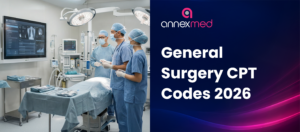Medical Coders are the unsung heroes of healthcare who ensure providers get paid right and paid well so they can focus on the best patient care. It’s a critical job, but also incredibly tedious. This is where Machine learning and Automation come into the picture. We all know that automation and AI are changing everything these days in the healthcare industry. New Al tools are stepping in to help automate Medical Coding services. In this article, we’ll look at the latest machine-learning systems that are taking over routine coding tasks. Let’s discuss how these technologies are increasing speed and accuracy while allowing our coders to focus on the most complex cases. Let us take a look at how machine learning has completely transformed medical coding services.
The Impact of Machine Learning on Medical Coding Services
Machine learning has significantly improved the medical coding process,
- Automated coding saves time and money – In the past, manual coding required many hours of reviewing medical charts and records in order to identify the correct codes. Medical coders can now save hours of time by using natural language processing, which can automatically suggest appropriate codes based on analysis of the unstructured material included in electronic health data. This is a cost-saving factor for healthcare service providers and expedites the coding process.
- Al improves coding accuracy – Over time, machine learning algorithms become smarter at deciphering medical jargon and determining the appropriate codes. As a result, fewer coding errors can affect billing and collections. Al-assisted coding is expected to maintain an accuracy rate of 95% or more, which helps guarantee that data used for research or public health efforts is accurate and that providers are rightly compensated for their services.
- Coding tasks are transformed – Coders can now focus on more intricate coding scenarios, while automation takes care of common coding duties. Their responsibilities will start to include managing exceptions, auditing the Al’s code recommendations, and taking on complex or unclear issues. Additionally, coders take on increasingly analytical tasks like as monitoring adherence to coding guidelines, spotting trends in data, and offering suggestions to enhance Al systems.
- The future is collaborative – Working together with Al and coders is the most efficient strategy. Al handles the bulk of the heavy lifting for simple, high-volume code, with human oversight, exception handling, and ongoing machine learning model improvement. Al and Human can each concentrate on their areas of strength thanks to this mutually beneficial partnership, which ultimately results in better medical coding overall. Al and coders can work together to improve healthcare by increasing accuracy, and efficiency, and gaining insightful knowledge from data.
How Automation Is Improving Accuracy and Efficiency
Automated medical coding tools also called as computer-assisted coding platforms are powered by machine learning to transform medical coding services. These tools have inbuilt automated coding suggestions along with audits for streamlining the coding process. Instead of manually reviewing the medical records that run for pages and keeping in mind all the coding guidelines, coders can simply review and verify automated coding suggestions. This allows them to code more charts in less time while maintaining high accuracy. These tools also have a rule engine system built in them that acts as a second-level audit to ensure no specific guidelines or rules are missed by catching any errors before submitting codes. Some automated coding tools even detect when additional diagnosis or procedure codes may be missing, helping to avoid rejected or denied claims.
Natural language processing enables automation to interpret unstructured data. By analyzing doctors’ notes, lab results, and other unstructured data, automation can learn and infer diagnoses and recommend appropriate codes. This feature becomes useful especially when coding complex cases like surgical or those with ambiguous documentation. Automation can look into all nuances that coders could miss. While automation cannot take over manual coding and coders, it enhances their skills and productivity. Coders have more time to focus on complex cases requiring human judgment. They can also spend more time ensuring documentation is clear and specific to support the codes. This results in higher-quality data and reimbursement.
Overall, machine learning and automation are optimizing medical coding services through increased efficiency, accuracy, and data quality. Together, human coders and intelligent technology are building a smarter, more robust coding process. The future is bright for this partnership.
The Future of Medical Coding Services With Al
Al and machine learning have already started transforming medical coding services. There are a lot of players who have started bringing in plug-and-play software for automated coding. These software are created specialty-wise to directly support providers without the need for data training. As Al systems get better at understanding medical terminology and procedures, they can take over some of the repetitive coding tasks currently performed by coders. This may significantly reduce the time and effort spent on basic coding.
Automating Simple Coding Tasks – Basic coding tasks like procedure coding, diagnosis coding for common conditions, and billing code selection can potentially be automated using Al. Many systems also support assigning the correct modifier to the codes to make sure they are billed to the highest level of specificity. Al systems can review medical records and notes to identify relevant codes much faster than a coder. They also do not feel fatigued which in turn results in errors. However, coders will still be needed to handle complex cases that require judgment and evaluation.
Enhancing Coder Productivity – Automation can also help enhance coder productivity by pre-coding medical records and suggesting potential codes. This can speed up the coding process and allow coders to focus on more complex coding work. All they need to do is quickly give a glance to ensure the codes are correct before billing. Some Al systems also use natural language processing to highlight relevant clinical details in the medical notes that may be useful for coding. This can help coders identify information faster.
Transitioning Coder Roles – As Al takes over some of the routine coding work, the role of coders may transition to more specialized, complex coding as well as auditing and optimizing Al coding systems. Coders with experience in multiple specialties and coding types may be in higher demand. Some coders may also transition into new roles like coding educators, auditors or healthcare data analysts. Coding organizations will need to invest in re-training and up-skilling their coding workforce to adapt to these changes.
Overall, while Al may significantly impact the medical coding field, human coders will continue to play an important role, especially for complex, specialized coding. A combination of human coders and Al systems will likely become the norm for efficient and accurate medical coding services in the future. With the right investments in technology and people, the field is poised to benefit immensely from Al.




























